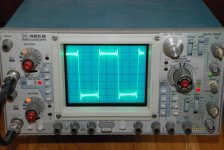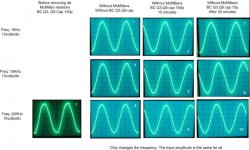Hi,
I did some tests too and posted them in my original thread:
http://www.diyaudio.com/forums/showthread.php?postid=1190647#post1190647
William
I did some tests too and posted them in my original thread:
http://www.diyaudio.com/forums/showthread.php?postid=1190647#post1190647
William
It seems there is no discussion on the situation in posting 39. I think this is a parasitic oscillation (not ringing).
I saw this in my Aleph5 and this can be cured by adding a 1000pF (1nF) cap across the gate resistors of the gain MOSFET and the output, i.e. -out and C of Q4 ; +out and C of Q9 (Grey's version dated 5/24/02).
The waveform is reproduced here:
I saw this in my Aleph5 and this can be cured by adding a 1000pF (1nF) cap across the gate resistors of the gain MOSFET and the output, i.e. -out and C of Q4 ; +out and C of Q9 (Grey's version dated 5/24/02).
The waveform is reproduced here:
Attachments
Hi Xavier
Just curious about your generator...
Do you use a CD player with a recorded square wave on a CD ? Your waveform looks like truncated Fourier series attempting to reproduce a square signal, or if you prefer, the Gibbs phenomenon.
If its ringing, it is damped as it begans to decrease until half the high or low levels of your squre wave. But then, why does it begin to re-rise agian after ? The ringing must follow a level change, not precede it Or get a patent on time reversal
Or get a patent on time reversal
If it's oscillations, why are they damped in the middle of the high and low levels ? And why is it so symmetrical ? The duration of a level is an exact multiple of the oscillation frequency. Seem to be too much luck...
Just have a look at the pictures here : http://en.wikipedia.org/wiki/Gibbs_phenomenon
Pretty the same, hu ?
May be I'm completely mistaken, but it strongly reminds me a digital problem... Just tell us where your square signal comes from
Cheers
Just curious about your generator...
Do you use a CD player with a recorded square wave on a CD ? Your waveform looks like truncated Fourier series attempting to reproduce a square signal, or if you prefer, the Gibbs phenomenon.
If its ringing, it is damped as it begans to decrease until half the high or low levels of your squre wave. But then, why does it begin to re-rise agian after ? The ringing must follow a level change, not precede it
If it's oscillations, why are they damped in the middle of the high and low levels ? And why is it so symmetrical ? The duration of a level is an exact multiple of the oscillation frequency. Seem to be too much luck...
Just have a look at the pictures here : http://en.wikipedia.org/wiki/Gibbs_phenomenon
Pretty the same, hu ?
May be I'm completely mistaken, but it strongly reminds me a digital problem... Just tell us where your square signal comes from
Cheers
CheffDeGaar said:Just tell us where your square signal comes from
You are right, Cheff. The signal is generated by a PC from a wav file and then feeds the preamp. It already has this shape at the input of the AX.
Xavier
Hi guys,
This link may help with understanding what is a happening.
http://stereophile.com/solidpoweramps/1103pass/index4.html
As I recall the review samples were not biased correctly but the clues are perhaps there. In that respect take the absolutes with a grain of salt but there is a trend with lower load impediances. In any case amp reviewed impressively compared to the Halcro on a subjective basis as one would expect.
Note the tests were done at 2 watts.
At 20 kherz the output impediance is relatively higher and given a 4 ohms load this has an effect on the FR response tests particularly at high power levels when doing such test.
With that increase in output impediance I suspect the voltage drop is converted to heat and you get the effect you have been discussing. I doubt if this is an issue in normal operation.
This is only my educated theory and I hope it facilitates some productive discussions.
best
Ian
This link may help with understanding what is a happening.
http://stereophile.com/solidpoweramps/1103pass/index4.html
As I recall the review samples were not biased correctly but the clues are perhaps there. In that respect take the absolutes with a grain of salt but there is a trend with lower load impediances. In any case amp reviewed impressively compared to the Halcro on a subjective basis as one would expect.
Note the tests were done at 2 watts.
At 20 kherz the output impediance is relatively higher and given a 4 ohms load this has an effect on the FR response tests particularly at high power levels when doing such test.
With that increase in output impediance I suspect the voltage drop is converted to heat and you get the effect you have been discussing. I doubt if this is an issue in normal operation.
This is only my educated theory and I hope it facilitates some productive discussions.
best
Ian
I tried removing the McMillan resistors and the behavior improved quite a lot. As a drawback, absolute offset starts with +12v and goes downto -9v after two hours. I will post some picts of the measurings I did in some minutes.
Ian,
Thanks for the link. I am trying to digest all this information and the additional information I got after removing the McMillans.
Xavier
Ian,
Thanks for the link. I am trying to digest all this information and the additional information I got after removing the McMillans.
Xavier
xavier1000 said:I tried removing the McMillan resistors and the behavior improved quite a lot. As a drawback, absolute offset starts with +12v and goes downto -9v after two hours.
Are you loading the output stage with resistance to ground?
Nelson Pass said:
Are you loading the output stage with resistance to ground?

I am currently using 33R to ground for each side.
I didn't have the chance to describe the pictures I post some hours ago.
Pict 7: this picture shows a 20KHz sinus wave just before removing the McMillan resistors. The distortion can be seen just before clipping.
Picts 1, 4, 8: after removing the McMillans and removing the caps between BC of Q3 and Q8. Pict 4 shows some distortion for 10KHz. Pict 8 shows no distortion because there is some attenuation of the signal.
Picts 2, 5, 9: same as before, but adding a 150p cap between B-C of Q3 and Q8. Pict 5 and 9 shows some distortion, but the amp had been working only 15 minutes. After some minutes, this behavior changed.
Picts 3, 6, 10: everything the same but after 15 minuts. The shapes improved and apparently almost no distortion can be seen. The text has a mistake since the capacitor is still 150p.
Xavier
Pict 7: this picture shows a 20KHz sinus wave just before removing the McMillan resistors. The distortion can be seen just before clipping.
Picts 1, 4, 8: after removing the McMillans and removing the caps between BC of Q3 and Q8. Pict 4 shows some distortion for 10KHz. Pict 8 shows no distortion because there is some attenuation of the signal.
Picts 2, 5, 9: same as before, but adding a 150p cap between B-C of Q3 and Q8. Pict 5 and 9 shows some distortion, but the amp had been working only 15 minutes. After some minutes, this behavior changed.
Picts 3, 6, 10: everything the same but after 15 minuts. The shapes improved and apparently almost no distortion can be seen. The text has a mistake since the capacitor is still 150p.
Xavier
Dear Xavier,
at the moment I am using McMilliam resistor (4k75) , and Cap between BC (of q3, q8) of 3.3 nF.
I am currently using 120R (I obtain the same result with 60R) to ground for each side.
With higher McMillian resistor the time to stabilize absolute offset is too long (the DC offset between + and – output is 20 mV), I tried using 40R to ground with no apparent positive results.
So now I can note the “strange distortion” just before the clipping (at high frequency >10kHz) .
Paolo
at the moment I am using McMilliam resistor (4k75) , and Cap between BC (of q3, q8) of 3.3 nF.
I am currently using 120R (I obtain the same result with 60R) to ground for each side.
With higher McMillian resistor the time to stabilize absolute offset is too long (the DC offset between + and – output is 20 mV), I tried using 40R to ground with no apparent positive results.
So now I can note the “strange distortion” just before the clipping (at high frequency >10kHz) .
Paolo
Hi Paolo,
I am not sure if you already tried that but, could you just try to remove the McMillan resistors while using the 40R resistors to ground. Then you switch on the AX (having disconnected the speakers) and, after let's say 1 hour, readjust V2 to have an offset near 0. Then test with the scope and check if you still have that distortion.
And don't forget to report any progress
Xavier
I am not sure if you already tried that but, could you just try to remove the McMillan resistors while using the 40R resistors to ground. Then you switch on the AX (having disconnected the speakers) and, after let's say 1 hour, readjust V2 to have an offset near 0. Then test with the scope and check if you still have that distortion.
And don't forget to report any progress
Xavier
Hi Macka,
The connection is as follows:
PC Generator --> DIY Aleph P 1.7 (balanced) --> AX
Input A of the scope is connected to out+ of the amp and input B to out-. Ground is connected to ground. Then Input B is inverted in the scope and both signals are added.
Regards,
Xavier
The connection is as follows:
PC Generator --> DIY Aleph P 1.7 (balanced) --> AX
Input A of the scope is connected to out+ of the amp and input B to out-. Ground is connected to ground. Then Input B is inverted in the scope and both signals are added.
Regards,
Xavier
- Status
- This old topic is closed. If you want to reopen this topic, contact a moderator using the "Report Post" button.
- Home
- Amplifiers
- Pass Labs
- Another Aleph X up and running

